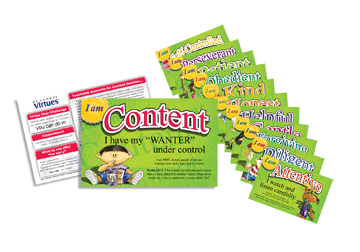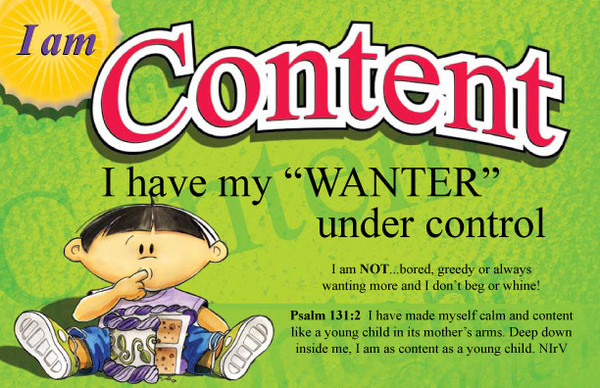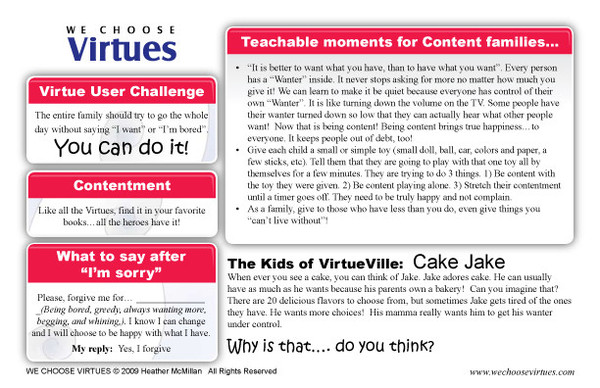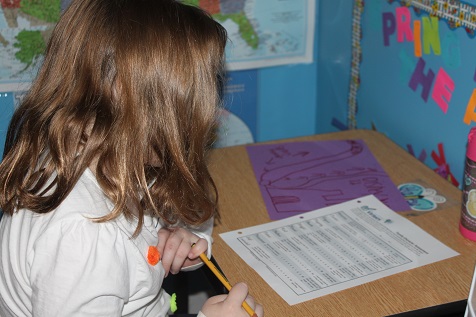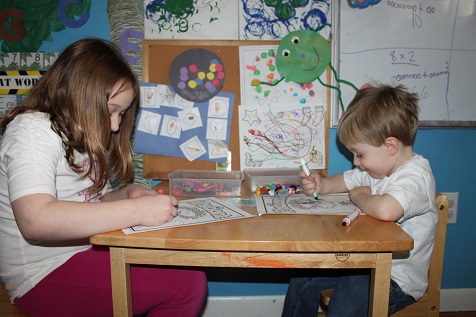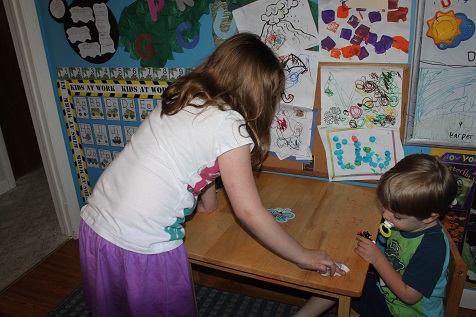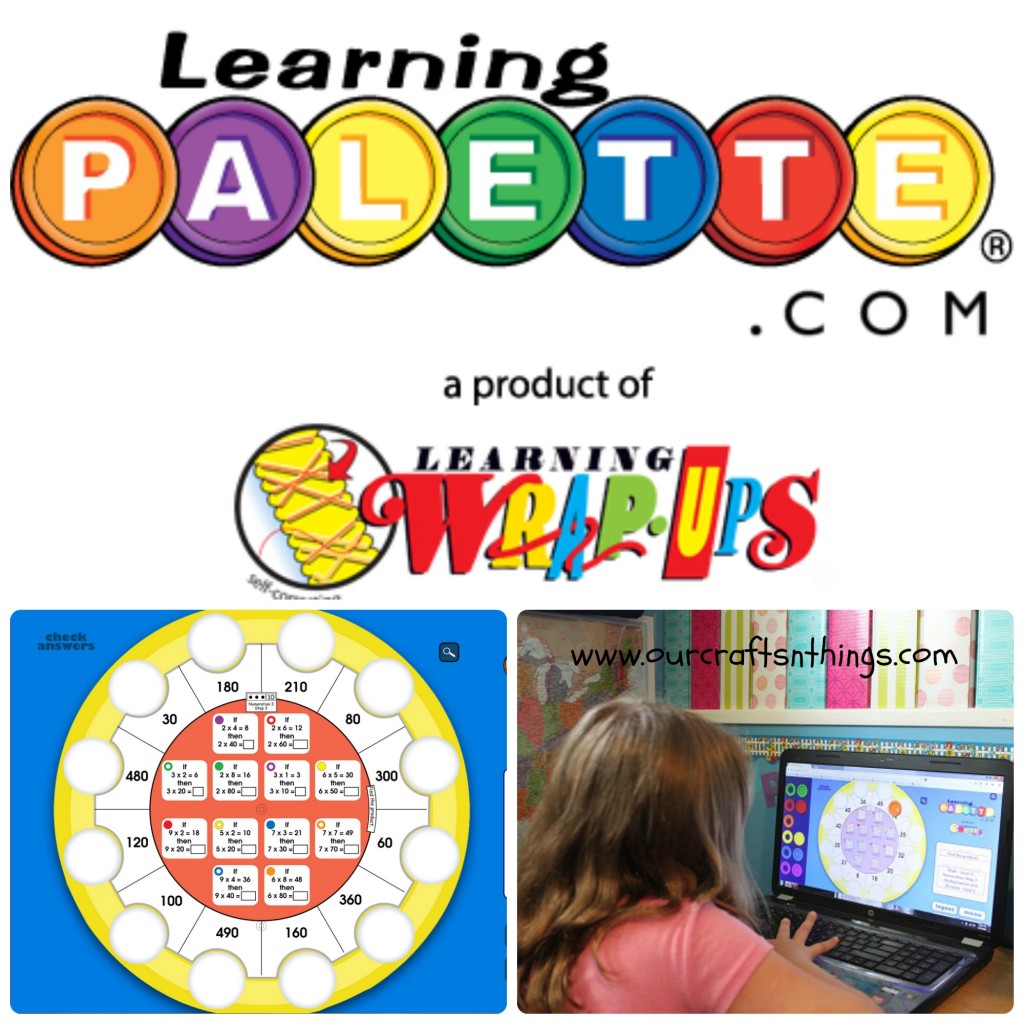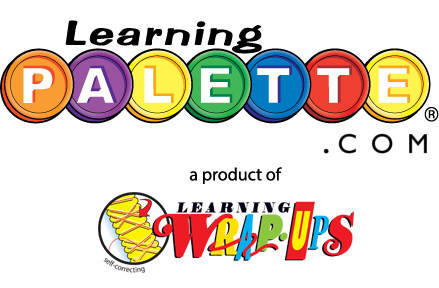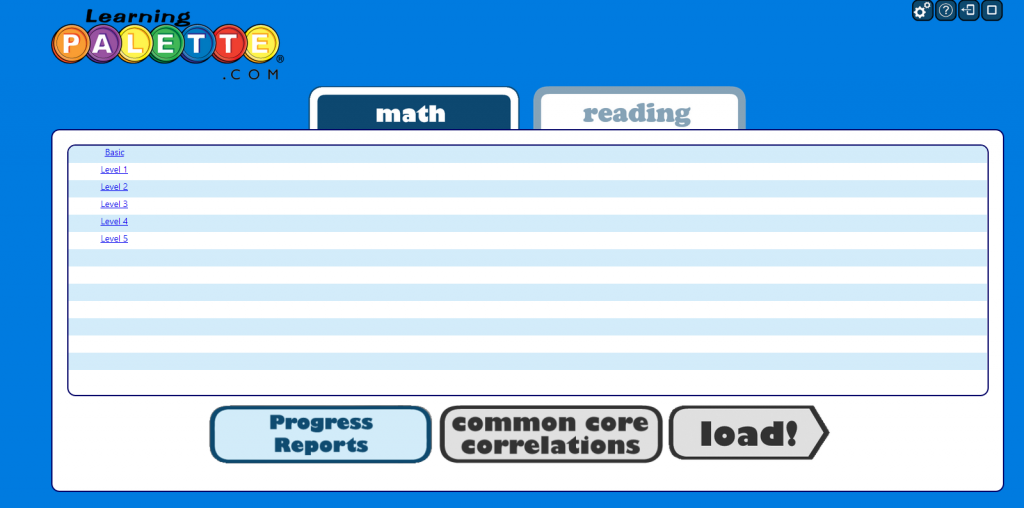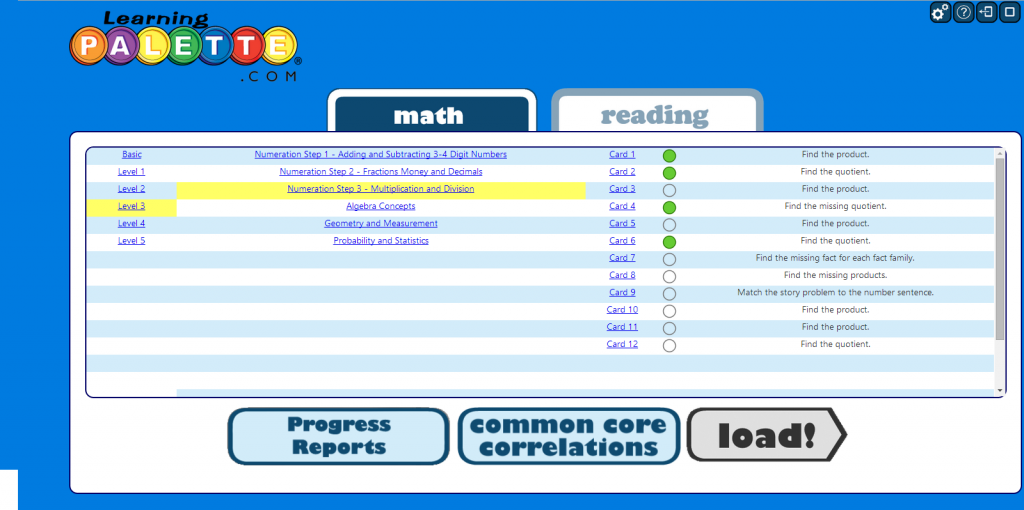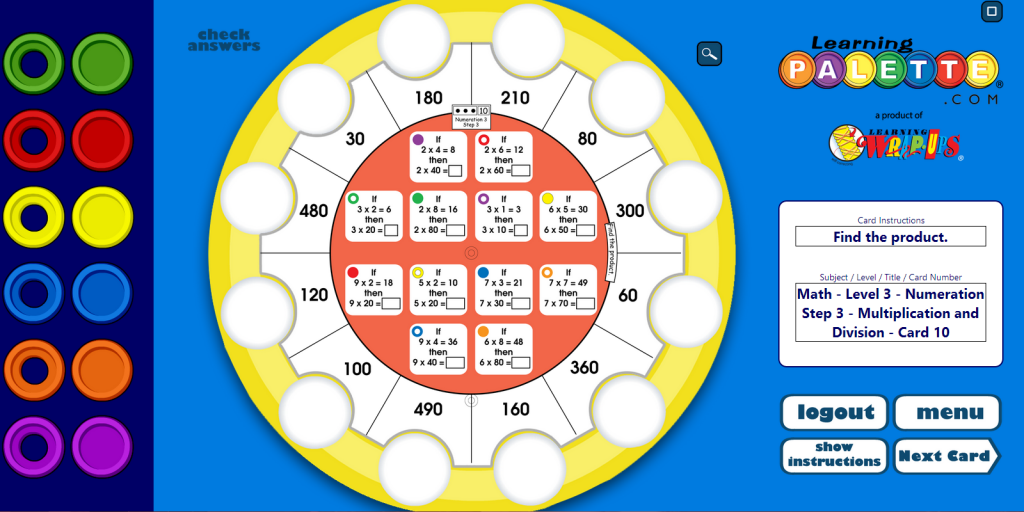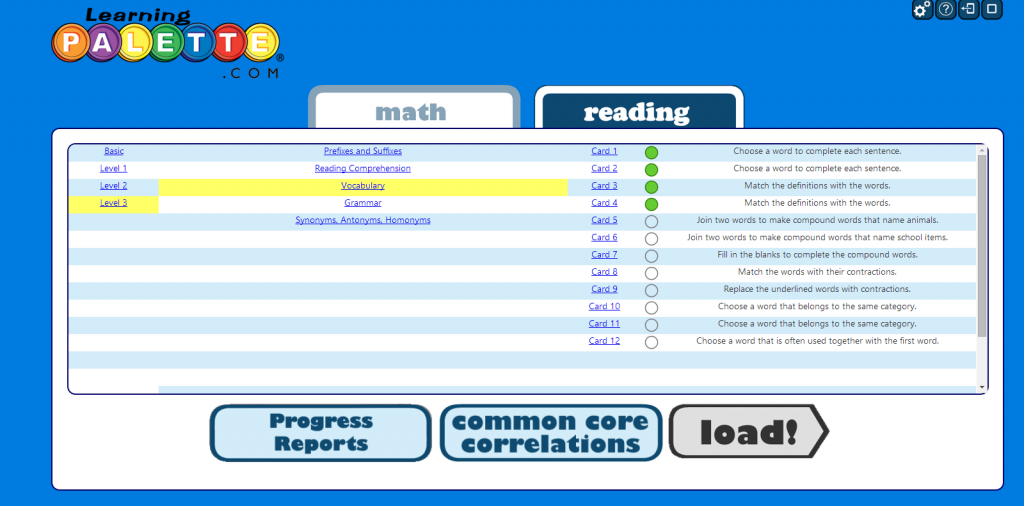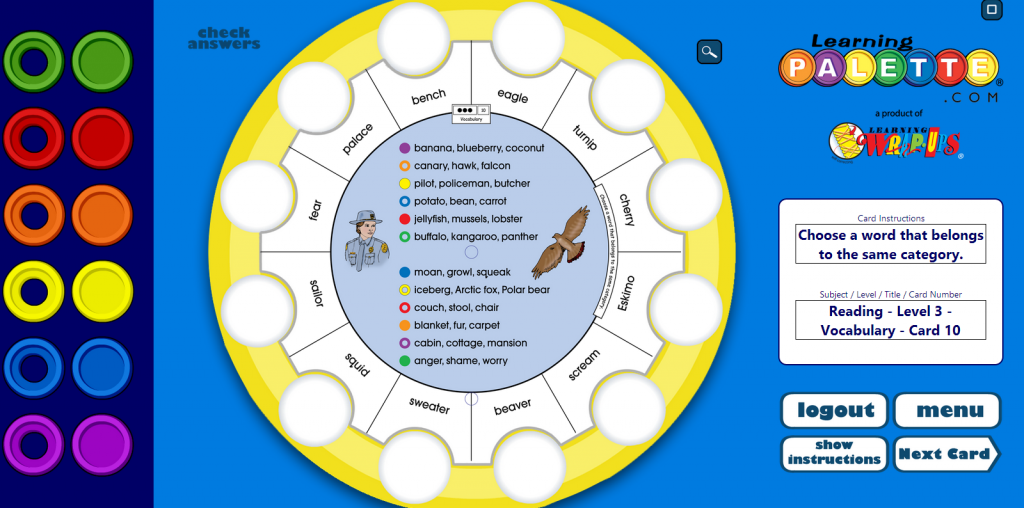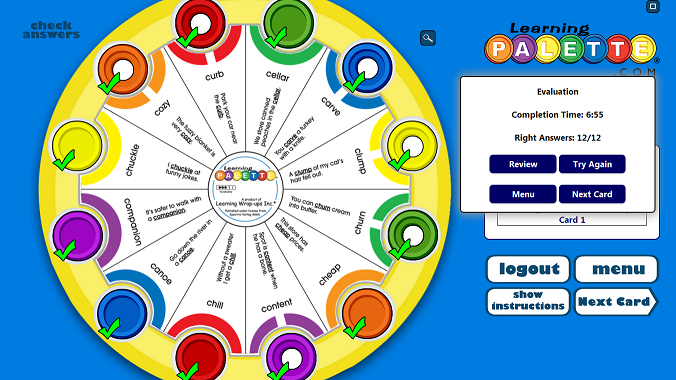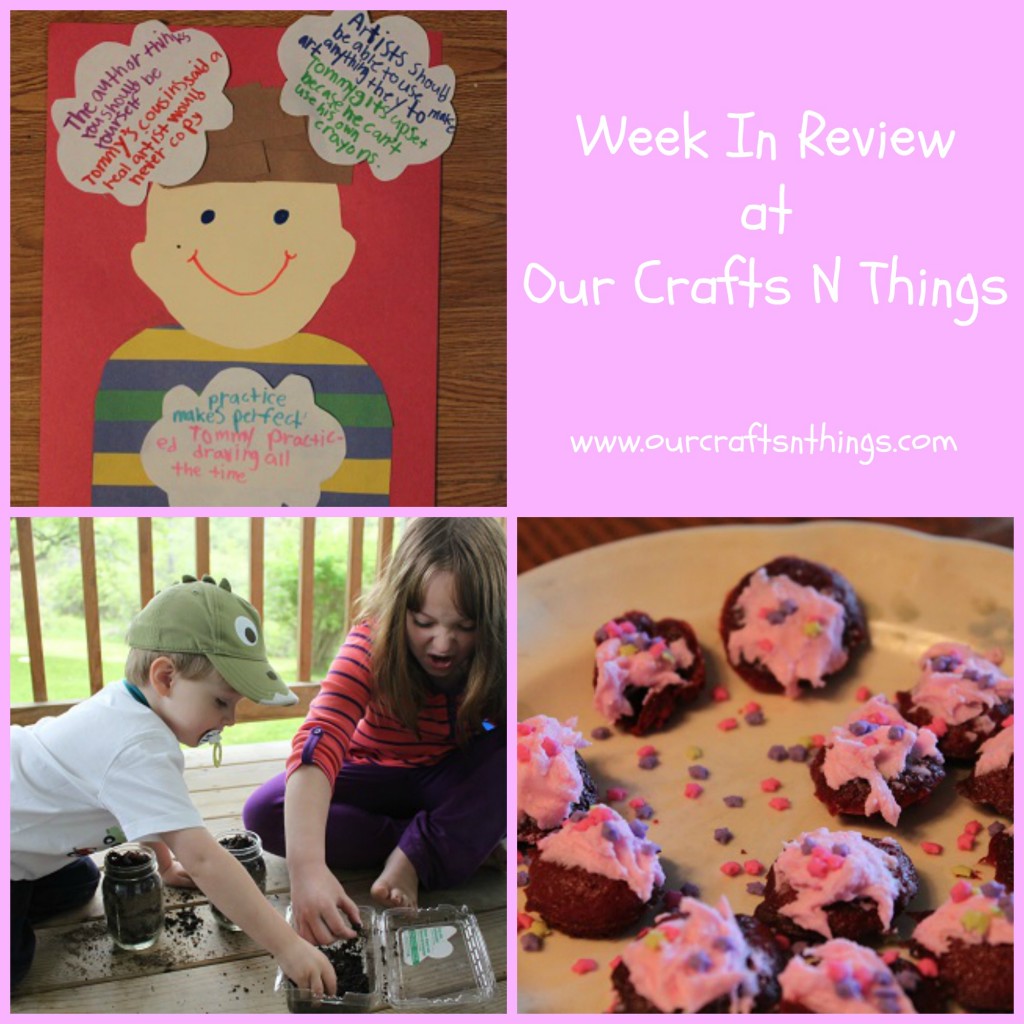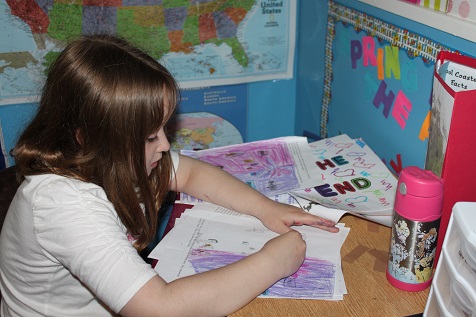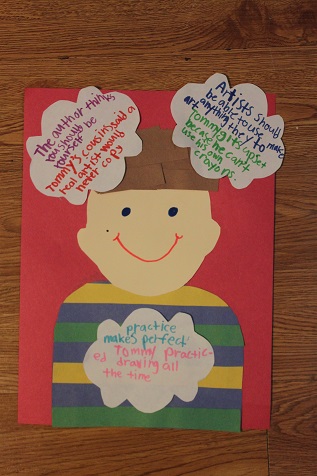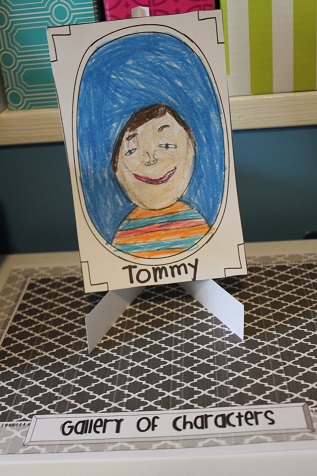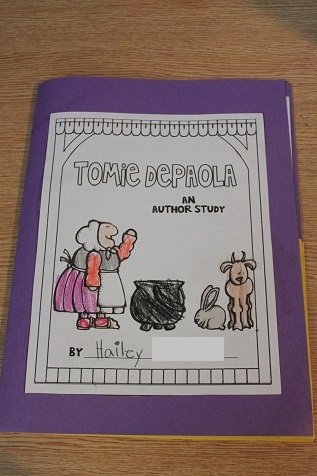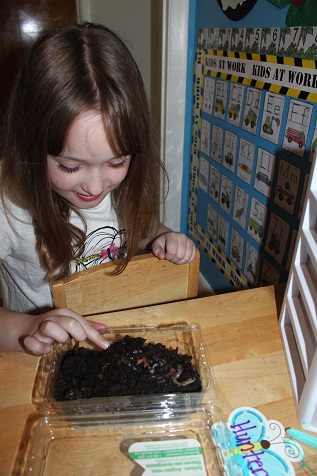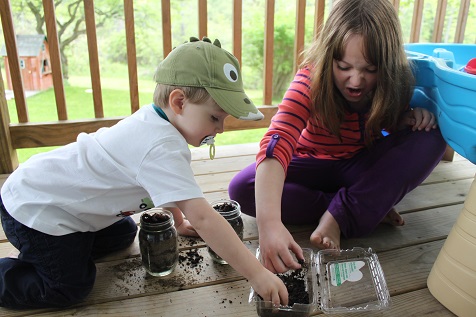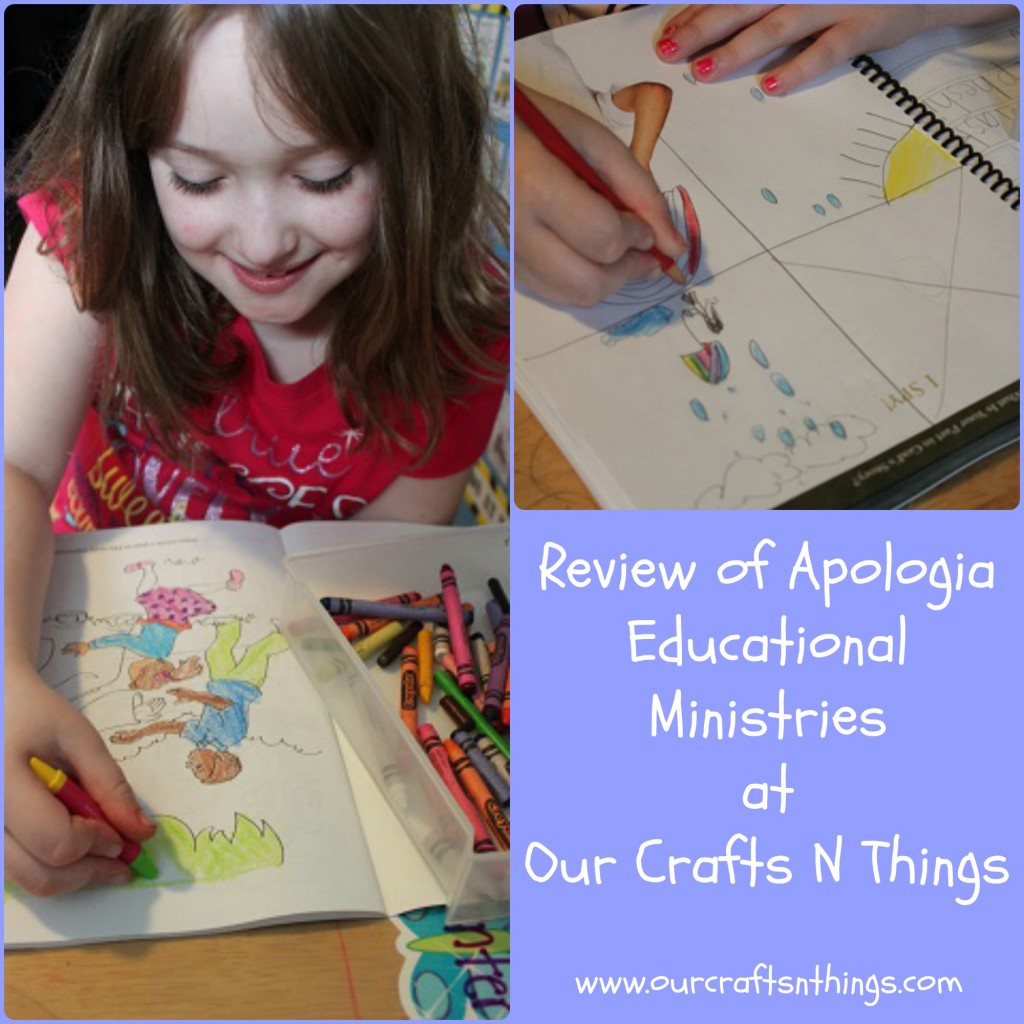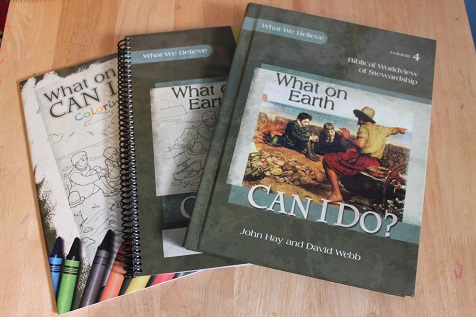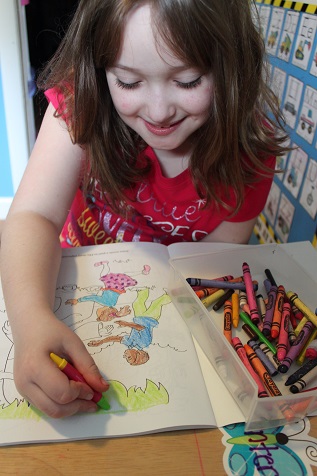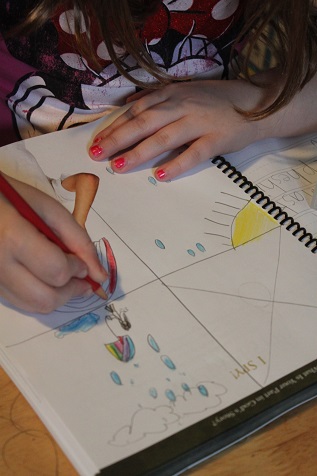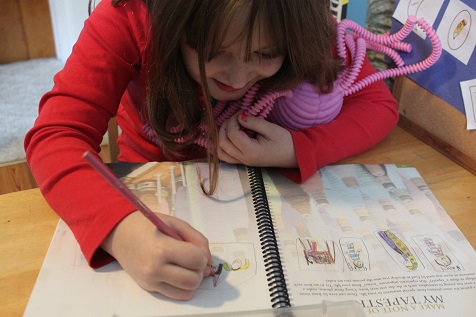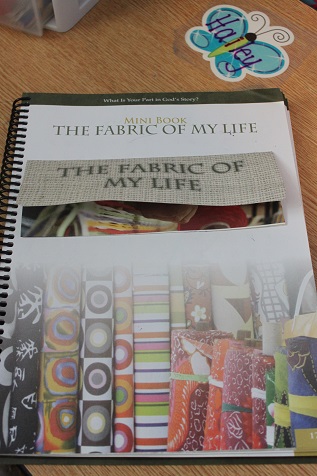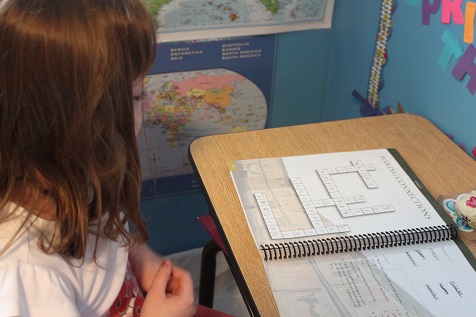Archive for the ‘Homeschooling’ Category
We Choose Virtues Review
Jun
I have seen We Choose Virtues mentioned on several blogs in the past and everyone always seemed to really like the program. So, I was really excited when we were given the chance to review the Parenting Cards from We Choose Virtues.

We Choose Virtues is a fun curriculum used to help teach your children about virtues. There are cute characters that the children will remember, and this will help them to remember the virtues they have been learning about and practicing.
The Parenting Cards are teacher cards to be used at home, basically the homeschool version of this curriculum. There are 13 cards, which are on printed on a card stock and are 8 1/2 x 5 1/2 inches big. These cards are an important part of the program and will be used every day. They are meant for kids ages 3-11 and cost $38.49. Each card includes a Bible verse and you can decide if you want it to be the NIrV or KJV.
We also received the WCV Download Bundle, which is for kids ages 3-11, is priced at $7.99 and includes the following items:
- Teacher’s Handbook
- Family Character Assessment
- Coloring Pages
- Butterfly Award
- Sing-along-Song sheets
This a closer look at what the cards look like- each card has a virtue and then a simple sentence or two about what that means in terms that kids understand. Under that is a Bible verse that goes along with the virtue being taught.
The back of each card has some teachable moments that give several suggestions for how to teach the virtue you are studying. There is also a little story to go along with each virtue in “The Kids of VirtueVille” section where you get to meet one of the characters from VirtueVille. The story always ends with a question to make kids think about why the character made the choice he or she made.
So, how did we use We Choose Virtues?
I started off by introducing what we were going to be doing. Hailey and I then both took the Family Character Assessment (PDF download). This was great to look at to find the areas that we both need to work on (and to see what our strengths are too). It is definitely easier to see the flaws in someone else than it is to see them in yourself…
Each week I chose a virtue card and added it to our calendar board. On the first day I read the story on the back of the card and we talked about what the virtue meant. The Teacher’s Handbook (PDF download) had some cute ideas to use to introduce and teach the virtues- so I used some ideas from there. Each day I did something different that was listed on the back of the card- none of the ideas take very long, they are very simple to do, but they really get the point across. They are a great parenting tool!
Hailey and Hunter both love to color, so each week they colored a page from the Kids of VirtueVille Coloring Pages (PDF download). The picture they colored was a picture of the kid they met on the virtue card. As soon as they finished coloring, Hunter wanted me to hang up the pictures right away- they are all hung up in a row and he really enjoys looking at them.
The week that we learned about being a helper was one of my favorite weeks- we learned about finding things that need to be done and just doing them without being asked. Hailey was amazing! She was constantly looking for things that needed to be done- like in the picture above, she decided to help by wiping Hunter’s desk clean after we had done a messy activity.
We Choose Virtues is a great way to help your kids learn and remember virtues. It really only takes a short amount of time each day to cover the virtue and to do an activity from the back of the card, but they teach some great lessons.
Here is what is boils down to for me:
Pros:
Easy to implement
Only takes a short time to use each day
Cute and memorable characters to help children remember the virtue
Hailey (age 7) and Hunter (age 2 1/2) both really enjoyed the activities we did and it is easily adaptable for a variety of ages.
Cons:
I wish that the Teacher’s Handbook was available as an actual book, rather than just a PDF. It is not necessary to print it, I just used it on my computer, but I really prefer to be able to hold a teacher’s guide in my hands when I look at it. This is definitely not necessary, just something I like and I am usually willing to spend a little bit more to be able to have an actual hard copy.
Right now there are a couple of discount codes that I am excited to share with you!
For the rest of June, use Promo Code BIG50 for 50% off a set of 12 11×17 Kids of VirtueVille Posters
For June-August, use Promo Code BTS20 for 20% off anything in the We Choose Virtues Store.
(You can only use one promo code per order.)
Want to see some more? Check out We Choose Virtues here:


LearningPalette.com Review
Jun
We were given the chance to review LearningPalette.com which is made by Learning Wrap-ups. I was given full access to LearningPalette.com which can be used for math or reading. The cost of a yearly membership to LearningPalette.com is $25 for one user or $60 for 5 users. There are pricing options for more users, up to 1000, so this is a product that homeschoolers or schools can consider. This product is geared for kindergarten through 5th grade.
LearningPalette.com is an online product, so you will need reliable access to the internet in order to use it. They also have hands on products you can purchase at Learning Wrap-Ups.
It’s hard to describe how LearningPalette.com works in words, so I took some screen shots while we used the product to better show it works.
This is the first screen in the math portion of the program. There is a basic level up through level 5. Once you pick your level you can pick the topic you want your child to study or review.
After you choose a topic- in this example I picked level 3, Numeration Step 3 -you are then given 12 cards to pick from for your child to work on. You can see that some of the cards have a little green circle next to them- those are the cards that Hailey completed in this particular topic.
After you pick a card, this is what you will see. This particular example is in math, level 3 and covers multiplication and division. (It is a bit hard to see, but if you click on the picture you can see a much bigger version.) So, once you click on the card your child will need to solve the math problem. After she has an answer she will need to look for the answer around the edge of the circle. Then she has to find the colored circle on the left hand side that corresponds with the question, and click and drag that to the correct answer.
The reading portion is similar to the math portion. There are 4 different levels- basic through level 3. Within those levels are different topics, and then the topics have 12 cards with different questions.
This is an example of a vocabulary card in level 3. This is the same set up as the math- your child will read the question, find the answer around the circle, then find the colored circle on the left that corresponds to the question and put next to the correct answer.
So, how did we use LearningPalette.com?
Hailey used levels 2 and 3 in both math and reading. We used it as a review or practice for things we had already covered. I didn’t find there to be any actual teaching, just questions that would go over things that had already been covered.
This is a screen shot of one of Hailey’s completed cards- it tells how long it took her to complete it and tells how many she got correct.
Usually Hailey really enjoys using activities on the computer, but when I asked her how she felt about LearningPalette.com she said it made her feel frustrated. I also used it and it was very confusing for me. I could easily answer the questions that were being asked, but to actually match up the correct circle- figure out which color to use and whether or not is was supposed to have a hole in it, then find the correct answer on the outside of the circle, made me confused. Another problem we had was that sometimes Haiely would “lose” a disc. If the colored circles got too close the edge of the screen they disappeared and there was no way to get them back. The system also did not keep track of all of the cards she completed. There were some cards she finished that were never counted as done.
Here is what it boils down to for me:
Pros:
We had access to all grade levels.
Hailey was able to work at her own pace- if she didn’t finish a card, she could come back later to finish it.
The card was immediately corrected so that Hailey could see what she had right or wrong.
Cons:
There are just too many steps to complete to answer each question- even though I quickly knew the answers, it took me a while to figure out which disc to put where.
It frustrated Hailey and confused me.
The cards are timed, which bothered Hailey because she felt like she was rushing to get it done rather than just figuring out the problems.
Overall, this was not a great fit for us. I definitely encourage you to read the reviews that others have posted because this is simply my opinion.


Week In Review
Jun
Here is a little peek at what we’ve been up to:
Language Arts:
Hailey has been working hard on writing a story. First she wrote up a rough draft, then we typed the story, and finally she is working on illustrating it.
We have been having a lot of fun doing an author unit study about Tomie dePaola from Around the Kampfire. In this activity, Hailey made her own version of Tommy- the boy from the book The Art Lesson. We talked about how an author can tell us how he/she is feeling by the things that happen in a book. For example, Hailey though that Tomie dePaola thinks that people should be themselves because in the story Tommy is told that a real artist would never copy.
As we read through the books we will add to our gallery of characters- for now this is Hailey’s drawing of Tommy from The Art Lesson.
This is the cute folder we made to keep all of Hailey’s work in from this unit.
Science:
We are learning all about worms during science. Hailey checking out some worms that we used for various activities.
Hunter and Hailey made little habitats for the worms to live in. I love the look on Hailey’s face as she is picking up a worm to put in her jar.
The jars had oatmeal on the bottom, then we layered them with sand and dirt. We put worms on the top and then added some leaves. We observed them and watched them build their tunnels.
Other:
Hailey has decided that she wants to add a weekly baking lesson- so she made us some delicious cupcakes.
Be sure to like me on Facebook and follow me on Pinterest so you don’t miss any of our fun activities.
Apologia Educational Ministries Review
May
I have been busily searching for a great Bible curriculum to use with Hailey next year. I never found anything I was super happy with this year, so I have kind of just pieced things together as went along. Next year I’ll have a newborn, so I want to make sure I find something that is nicely laid out for me without much prep work involved. I was given the chance to review What on Earth Can I Do? from Apologia Educational Ministries and I was really excited to check it out. I knew that Apologia has a great science curriculum, but I didn’t realize they had a Bible curriculum as well.
We used What on Earth Can I Do? ($39.00), the What on Earth Can I Do? Junior Notebooking Journal ($24.00) and the What on Earth Can I Do? Coloring Book ($8.00). We also received the What on Earth Can I Do Notebooking Journal ($24.00).

What On Earth Can I Do? is the 4th book in the christian worldview series- What We Believe by Apologia. The book is a hardcover textbook that has 8 lessons and 294 pages that helps children understand that God gave each of us special gifts to be used for His glory. It is designed to be used with children in grades 1-6. The lessons can be spread out as long as you see fit for your family. There is a suggested schedule at the beginning of the book which would make each lesson last for 3 weeks. You could stretch them out longer or do them quicker, whatever works best for you.
The 8 lessons cover:
- Your story or God’s story?
- Who put you in charge?
- Will you be found faithful?
- Where is your treasure?
- Where does your time go?
- Whose life is it anyway?
- Why isn’t it easy being green?
- What will happen when the master returns?
Then, within those lessons there are several components that you will see covered each time. For example, each lesson has a section called The Big Idea which introduces the main topic in that lesson. There will also be a Short Story which tells a story about other children and gives a little glimpse into their lives. There is also a section called Hide It in Your Heart– where there are memory verses for your child to memorize. You will also find a section called Parables of Jesus which is a parable from the Bible that has been adapted to help students have a better understanding of the story. There are several other important components to each lesson, but that is just a brief description of a some of them.


So, how did we use What on Earth Can I Do?
I planned to have our lessons be a little shorter than the recommended schedule in the book. Hailey usually gets a little restless if I read too long, so I didn’t want her to get tired of listening to me read. Plus, with a busy toddler, sometimes it’s hard to have uninterrupted reading time. But, when I was reading the short stories or the parables for Jesus, Hailey begged me to read a little bit more. And, Hunter actually sat and listened too.
While I read to Hailey from the textbook, she colored in the coloring book.
After we read the section for the day in the textbook there were notebooking pages to be completed.
This particular page is called “I Spy.” Hailey had to write or draw about where she had seen God’s works recently. She decided to draw a rainy day where the sun came out and then a rainbow formed.
We also learned about what a tapestry is and how God uses the different events in our lives to develop us into who we are today. Hailey had to design a tapestry that showed important scenes from her life. She included things like when she was born, when Hunter was born, her first day of school, doing gymnastics and more.
She made this mini book about the fabric of her life.
There are also pages to help reinforce vocabulary being learned, such as word searches and cross word puzzles.
What On Earth Can I Do involves very little prep on the part of the parent- just get your textbook and notebooking journal out and you’ll be ready to go. I found it to be easy to use and Hailey enjoyed listening to the readings.
Here is what is boils down to for me:
Pros:
Hailey really enjoyed the stories, and I did too. They really kept our attention and we did not want to stop reading.
The notebooking journal reinforced what we were reading and had fun and educational activities.
It is easily adaptable for a variety of ages.
You can make the lessons as long or as short as you need them to be for the attention span of your children.
Cons:
Ummmmm… I can’t think of any 🙂 It is so easy to adapt it to fit your needs that I don’t think there are any cons.
Want to see some more of Apologia? Check them out here:
Facebook
Twitter
Google+
Pinterest


